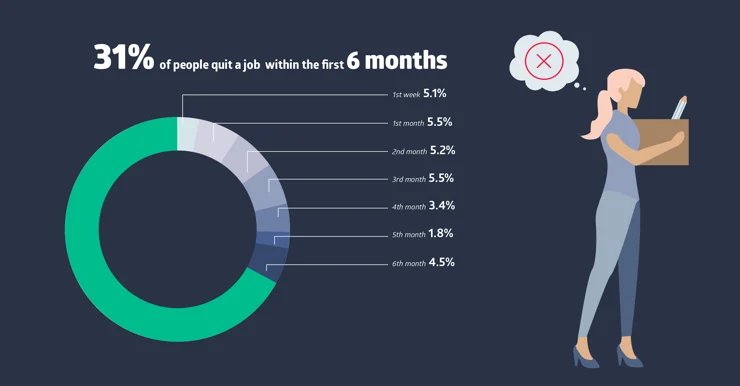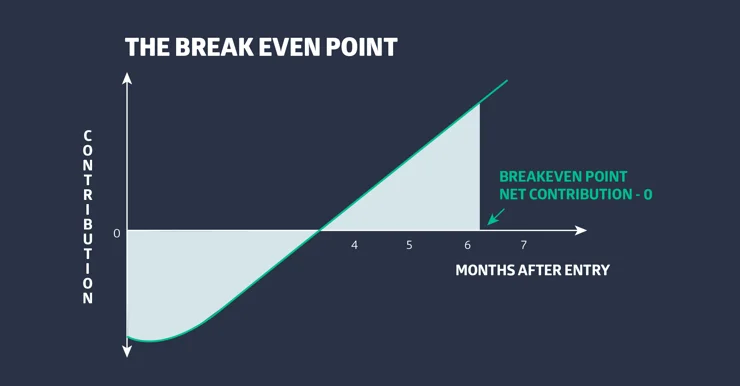5 Onboarding Tips to Boost Employee Engagement and Retention

Onboarding new hires is a crucial process within an organization, although many companies still don’t seem to consider it a priority. Welcoming and onboarding a new employee across a larger span of time will yield long-term benefits to your company, stimulate that employee’s engagement and devotion to your brand, increase productivity and effectively increase your employee retention rate. Check out Ambassify’s onboarding checklist!

Amanda has just been hired for a new position. After a perfunctory “employee onboarding” routine, she read and signed compliance paperwork and she’s thrown into the deep end and expected to manage.
If you’ve had a first day like that, you know exactly how it feels. You feel disoriented, confused, anxious, and lonely. On top of all that, you make a lot of mistakes until you finally learn the ropes.
It’s not unusual for the Amandas of the workforce who’ve had this type of experience to feel unmotivated, unproductive, and uncommitted to their new company. A bad onboarding experience can prompt a decision to quit within the first six months of landing a new job.
Easily manage an engaging onboarding process with Ambassify
Chat with an expert

This decision is a source of stress for the employee, but it can also be a significant resource drain for employers. A high turnover rate and the replacement of employees cost money and damage a company’s employer brand.
One thing to mention before diving into the details and intricacies of onboarding is the importance of an accurate and targeted recruitment process. Online assessment or pre-employment testing is a crucial component of the recruitment process as it helps identify candidates with the right skills, knowledge, and cultural fit for the organization.
Pre-employment testing can actually transform your online assessment process through tests tailored to measure specific job-related competencies as well as personality traits that can determine whether a candidate will be a good fit for your team and your organization. This not only reduces the risk of a poor hire but also streamlines the onboarding process: candidates who have demonstrated their suitability through pre-employment tests are likely to experience a smoother, more efficient integration into the team and faster productivity.
Numerous studies have shown that good employee onboarding positively impacts productivity, motivation, and employee engagement. This is why now more and more companies are paying greater attention to their internal employee onboarding processes, and even relying on a recruitment management system to manage their recruitment efforts from start to finish. These tools can efficiently run candidate relationships, track application statuses, and provide valuable metrics for assessing the effectiveness of recruitment efforts.
This data-centric approach enables businesses to make informed hiring decisions, enhance the candidate experience, and ultimately build a more robust and competitive workforce.. If your goal is to retain more employees and set them up for success from day one, then bear in mind that extreme makeovers and substantial changes may be needed.
But what is the actual purpose of employee onboarding, and how it connects with employee engagement, you ask?
Let’s talk about employee onboarding
Every organization has some sort of employee onboarding process, but not every organization has a good one. The minute a new hire accepts the job, onboarding begins. In most cases, it involves zero activities until their first day in the office (which is a mistake), and even then, it can be no more than a speedy welcome and an office tour before the new guy or girl is put to work.
But here’s the thing — the better your organization is at onboarding employees, the sooner they’ll bring value to the company. In ideal circumstances, new hires consume value for the first three months. Their contributions either get them to the break-even point or slightly above it in the next three months.
And that’s just when the onboarding process is perfectly tailored to them, and the organization rallies behind them to help them succeed.

Now, imagine that curve with no onboarding at all walk them through company culture’s finer points into their role, and some never do.
Effective onboarding focuses on ongoing processes that allow new employees to learn about the organization and their role in it. Continuous pop-up sessions and briefings about organizational structure, vision, mission, and values are crucial for the new hire to get into the right mindset and headspace. Unfortunately, a lot of organizations still don’t see it as a priority.
According to the Aberdeen Group study, effective onboarding results in:
- 66% increase in employee retention.
- 62% better time-to-productivity ratio.
- 54% increase employee engagement.
The decision to stay and to go above and beyond for a company is a decision that’s made with the heart, not with the head. Even employees who decide to stay but don’t feel as engaged with the company will be a dead weight for you if you don’t find a way to make them feel part of the team and boost their morale and productivity, which is why employee retention is also crucial as a following up the onboarding process.
Here are five tips that will help you design a great onboarding experience, and allow you to transform new hires into satisfied and engaged employees faster.
Start the process ASAP
Onboarding can start as soon as the employment contract is signed, which can sometimes be several weeks in advance of the new employee’s start date.
This process is called pre-boarding, and, of course, pre-boarding is not an intensive process, but there are, nevertheless, small (but critical) things that you can do during this period that will demonstrate your commitment to the process, and slightly unburden new employees during their first few days at the company.
- Communicate company policies and procedures. This way, new hires have a chance to ask questions and clear up ambiguities.
- Distribute logins and credentials. Have your IT department contact the employee to set them up with all the necessary accounts.
- Invite new hires to possible networking events. If you have one going on, that is, otherwise team calls, teambuilding events, or an after-work gathering will do it.
Have a plan and commit to the long-haul
A lot of organizations that have a formal onboarding program do really well in the first few weeks. After that, things kind of taper off — the new employee settles into their role a bit, and everyone just assumes that they’re doing fine.
It turns out most new employees take longer to acclimatize to their new situation and even longer to become fully productive members of the organization.
After the first few weeks, onboarding activities don’t have to be frequent, but they have to be purposeful and useful. It’s best to focus on relationship-building and company culture activities so that new employees feel socially connected and supported. To do so, you can also rely on HR systems such as SenseHR to manage and support your workforce.
Focus on relationships
Efficient onboarding programs boost employee engagement because they focus on quickly integrating new hires into the collective. Strong relationships are crucial to making new employees feel supported and valued. You can help build these relationships faster when you incorporate certain activities into your employee onboarding program, such as:
- New employee mentorship. Create a buddy system in which new employees are paired with veteran employees who can help them navigate company waters for the first few weeks.
- Set up personal introductions. Organize get-to-know-each-other meetings between the new employee and several of their close coworkers and other important stakeholders.
- Encourage participation in different company programs. These programs can range from informal workout sessions on the premises to formal employee advocacy initiatives.
Find out how to nurture a strong relationship with your employees
Discover AmbassifySet clear expectations
According to a Gallup study, only around half of all employees know, without a shadow of a doubt, what’s expected of them. And that’s all employees, not just the newcomers.
Of course, you want to avoid this at all costs. It’s especially frustrating for new hires since they feel insecure enough already, and want to prove that they were hired for a reason. That’s difficult to do if they don’t have a clue about what’s expected of them.
Here are some tips on how to effectively communicate expectations to your new employees:
- Have this conversation on day 1. Don’t postpone. You’ve unburdened the new hire during the first week specifically so you could focus on the important stuff, and there’s nothing more important than them getting a grasp on how they’re expected to contribute.
- Explain duties and responsibilities in detail. Ideally, someone doing the same job will be able to go into the nitty-gritty of things with the new employee. This will help them get that first-hand information that’s often crucial for them to hit the ground running.
- Focus on team expectations. It’s important for new hires to settle comfortably into their teams. Explain to them what teamwork looks like in your organization, how feedback is given and received, and how big wins are celebrated.
Involve senior leadership
Even if you do everything you can to wrap up the boring stuff like paperwork, IT, and tours during the pre-boarding phase, chances are that the employee’s first day on the job will still be packed with the mundane. What’s often lacking during that period is one crucial ingredient — inspiration.
That’s easily fixed when you involve a senior manager in the onboarding process. CEOs, VPs, and department heads are in the best position to talk to employees about the company’s vision and goals and to walk them through the finer points of company culture.
Onboard for engagement and success
The effect that unsupportive onboarding has on employee engagement is real and considerable. We actually wrote a dedicated article on how to measure employee advocacy. Unsupportive onboarding almost always results in low workforce morale, a longer time-to-productivity ratio, and a damaged company reputation.
Yet, structured onboarding programs are connected with better work outcomes and a more productive and engaged workforce. These programs do take a bit more time and planning to implement, but when you get them just right, you’re doing your new hires (and your bottom line) a huge service.
Revolutionize your onboarding and engagement strategy with Ambassify
Book a demo